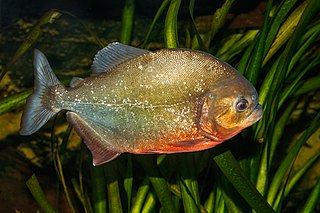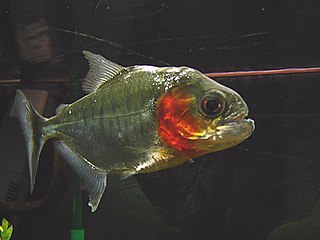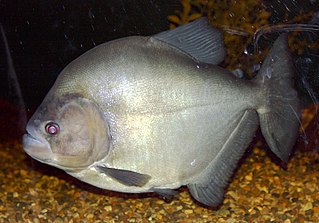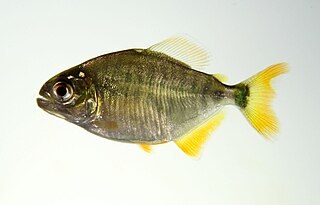
A piranha or piraña is one of a number of freshwater fish in the family Serrasalmidae, or the subfamily Serrasalminae within the tetra family, Characidae in order Characiformes. These fish inhabit South American rivers, floodplains, lakes and reservoirs. Although often described as extremely predatory and mainly feeding on fish, their dietary habits vary extensively, and they will also take plant material, leading to their classification as omnivorous.

Serrasalmus is a genus of piranhas. They are collectively known as pirambebas; the "typical" piranhas like the piraya piranha are nowadays placed in Pygocentrus. Like all piranhas, Serrasalmus are native to South America.

Pygocentrus is a genus of the piranha family Serrasalmidae. All species are native to tropical and subtropical South America. All the species are predatory, scavengers and may form large schools. The famous red-bellied piranha, Pygocentrus nattereri, is one of four species in the genus.

The redeye piranha, also known as the black piranha, white piranha, spotted piranha or yellow piranha, is a species of freshwater ray-finned fish, a piranha from the family Serrasalmidae. It is found in northern South America. It is the type species of the genus Serrasalmus.

The Serrasalmidae (serrasalmids) are a family of characiform fishes, recently elevated to family status. It includes more than 90 species. The name means "serrated salmon family", which refers to the serrated keel running along the belly of these fish. Fish classified as Serrasalmidae are also known by these common names: pacu, piranha, and silver dollar. These common names generally designate differing dental characteristics and feeding habits.

Steindachneridion is a genus of South American pimelodid catfish.
Oxyropsis is a genus of fish in the family Loricariidae native to South America. These species are distinguished by the presence of a single row of enlarged odontodes along the trunk midline lying adjacent and immediately dorsal to, the lateral line canal. Species of this genus have a depressed head and have relatively large eyes placed ventrolaterally. This genus is most similar to Hypoptopoma in external appearance, which shares the head shape and eye placement. Oxyropsis are elongate and have a narrow caudal peduncle, which distinguishes it from all other Hypoptopomatinae genera except Niobichthys and Acestridium.

Henonemus is a genus of pencil catfishes native to South America.

Bryconops is a genus of freshwater fish in the family Iguanodectidae from South America. It consists of small fish, all under half-a-foot long, with slender bodies and silvery scales, though there is some mild color variation. Several species can be identified by way of a humeral patch, and others have a reddish ocellus, or eyespot, on one or both lobes of the dorsal fin.
Pristobrycon careospinus is a species of serrasalmid endemic of Venezuela.
Pristobrycon maculipinnis, sometimes known as the marbled piranha, is a species of serrasalmid endemic to Venezuela.
Pristobrycon striolatus is a species of serrasalmid fish.

Moenkhausia is a genus of freshwater fish in the family Characidae native to tropical and subtropical South America. These are medium-sized tetras where the largest species only reach around 12 cm (4.7 in).

Pygopristis denticulata, or the Lobetoothed Piranha is a species of piranha. These fish are part of the group Ostariophysi, a large group of freshwater fish that includes minnows and catfishes. It is a rare South American fish found in the Orinoco River basin, north and eastern Guiana Shield rivers, and tributaries of the lower Amazon River. Piranhas typically live in freshwater, but other specimens can be found elsewhere. Specimens of this species is frequently found in acidic clear or black waters. Piranhas are primarily known for being savage, flesh-eating fish, but they actually have broader diets. They usually feed on aquatic insects, small fish, and fruits.

Deuterodon is a genus of characins from river basins in southern and southeastern Brazil, with a single species of uncertain taxonomic status, D. potaroensis, from Guyana. These are small fish that reach up to 12.6 cm (5.0 in) in total length. They are omnivores with a specialized mouth structure that allows them to scrape algae and debris off bedrock.

Apareiodon is a genus of scrapetooths from South America where they are found as far south as Río de la Plata. There are currently fifteen described species in this genus.
Pygocentrus palometa is a species of piranha native to South America, where restricted to the Orinoco Basin. Although recognized by FishBase, the scientific name may be a nomen dubium.

Iguanodectidae is a family of freshwater fish in the order Characiformes that lives in South America. It is home to the subfamily Iguanodectinae and the monotypic Bryconops clade. Several species in the family, such as the green line lizard tetra, the tailspot tetra, and the orangefin tetra, are sometimes taken as aquarium fish.
Bryconops durbinae, sometimes listed under the name Bryconops durbini, is a small species of freshwater fish in the family Iguanodectidae. It is the smallest species of the genus Bryconops. Like all members of Iguanodectidae, it inhabits rivers in the upper half of South America.

Bryconops giacopinii is a mid-sized species of freshwater fish in the family Iguanodectidae. It is the largest member of the genus Bryconops, and is therefore difficult to confuse with any of its congeners. With a diet that consists largely of land-dwelling insects, it serves as an important link between the terrestrial and aquatic aspects of its native range.












